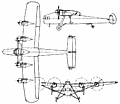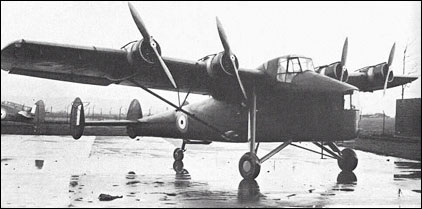|
| The Royal Navy envisaged a need for an aircraft that could shadow enemy fleets at night and the resulting Specification S.23/37 called for a slow-flying silent aircraft with a long range, capable of operating from an aircraft carrier flight deck. The specified performance was to be a speed of 70km/h at 500m for not less than six hours.
Five companies showed interest - Percival, Short Brothers, Fairey Aviation, General Aircraft Ltd and Airspeed. General Aircraft put forward the G.A.L.38, of very similar general design to the A.S.39.
The A.S.39 design was a high-wing aircraft with four small Pobjoy Niagara V engines spread across the wings with fixed landing gear and an observer's position in the nose. As for other aircraft carrier planes, the wings folded for storage.
Of two prototypes started, only one was completed, flying on 17 October 1940. The other was not complete when the Navy called time on it and the competing G.A.L.38, the requirement for such aircraft having been made obsolete due to the introduction of radar.
 | A three-view drawing (900 x 777) |
| MODEL | AS.39 |
| CREW | 3 |
| ENGINE | 4 x 130hp Pobjoy Niagara V |
| WEIGHTS |
| Take-off weight | 3147 kg | 6938 lb |
| Empty weight | 2083 kg | 4592 lb |
| DIMENSIONS |
| Wingspan | 16.25 m | 53 ft 4 in |
| Length | 12.2 m | 40 ft 0 in |
| Height | 3.17 m | 10 ft 5 in |
| Wing area | 43.85 m2 | 472.00 sq ft |
| PERFORMANCE |
| Max. speed | 185 km/h | 115 mph |
| Ceiling | 1830 m | 6000 ft |
| lxbfYeaa, e-mail, 14.03.2024 05:15 20 reply | | BHH, 04.12.2022 07:13 Like many weapons of WW2, this thing was conceived and built because of a feared shortage of a particular material or technology; in this case, Radar. But as this thing (and its General Aircraft near twin) was being developed, the people making radar sets were also working away feverishly. But the time these aircraft were in the air and being tested, revealing their shortcomings, Radar sets were catching up with demand and thankfully, no aircrew were ever endangered by taking these things into service. reply | | Klaatu83, e-mail, 17.08.2012 16:02 This was essentially an early form of stealth aircraft. The function these aircraft were designed to perform would today probably be carried out by means of satellites or unmanned Aerial Vehicles. reply | | Matt Reilley, e-mail, 26.03.2012 06:11 Having trouble locating specific information for this plane. I am wanting to know; who was the cheif designer and who all was on the design team? reply | |
| | J Taylor, e-mail, 06.12.2011 13:49 is this the a /c that ,it was said,actually flew backwards in a strong headwind? reply | | David Miles, e-mail, 30.03.2010 16:21 This extraordinary aircraft was to be seen by me,flying over Portsmouth in the early 1940's. Its name was whispered in Portsmouth, because it was, reputedly, so secret. It was flying quite low - less than 1,000 feet - was very quiet, thanks to the Pobjoy engines,and flew so slowly that I thought I could overtake it on my bike ! Wrong, of course, but it did seem almost to hang in the air. reply |
|
Do you have any comments?
|
| 
COMPANY
PROFILE
All the World's Rotorcraft
|







